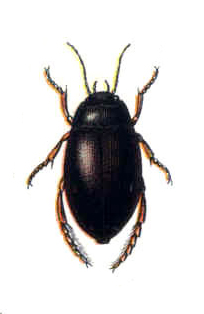| Ilybius fenestratus | |
|---|---|
 | |
| Ilybius fenestratus | |
| Scientific classification | |
| Domain: | Eukaryota |
| Kingdom: | Animalia |
| Phylum: | Arthropoda |
| Class: | Insecta |
| Order: | Coleoptera |
| Suborder: | Adephaga |
| Family: | Dytiscidae |
| Genus: | Ilybius |
| Species: | I. fenestratus |
| Binomial name | |
| Ilybius fenestratus (Fabricius, 1781) | |
Ilybius fenestratus is a species of beetle found throughout Europe and Northern Asia. It was first described by Johan Christian Fabricius in 1781. [1]
The scent gland of this species of beetle is natural source for the anabolic steroid boldenone (Δ1-testosterone). [2]